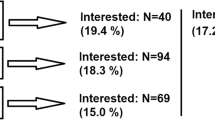Abstract
Boron (B) levels were determined in the serum of 980 healthy inhabitants living in an urban area of Japan by means of inductively coupled plasma emission spectrometry (ICPES).
The results showed a log-normal distribution of serum B for both sexes, although there are age-related differences. In male subjects, serum B increases rapidly up to 49 yr of age, reaching a plateau between ages 50 and 69 yr old, followed by a gradual increase up to 70 yr or older. Female subjects exhibit a gradual increase up to the age of 70 yr old. The reference value for male and female subjects was 79.8 μg/L and 67.9 μg/L, and the reference interval was 33.3–191.2 μg/L and 29.5–154.9 μg/L, respectively.
The obtained reference value and interval of the nonexposed group may be useful for health screening for B exposure, either for people living in regions with high levels of B in the environment, or for workers who are exposed to this element.
Similar content being viewed by others
References
R. J. Weir and R. S. Fisher, Toxicologic studies on borax and boric acid,Toxicol. Appl. Pharmacol. 23, 351–364 (1972).
A. Miyazaki and K. Bansho, Determination of trace boron in natural waters by inductively coupled plasma emission spectrometry combined with solvent extraction,Anal. Sci. 2, 451–455 (1986).
D. H. Wegman, E. A. Eisen, X. Hu, S. R. Woskie, R. G. Smith, and D. H. Garabrant, Acute and chronic respiratory effects of sodium borate particulate exposures,Environ. Health Perspect. 102 (Suppl. 7), 119–128 (1994).
A. A. Ferrando, N. R. Green, K. W. Barnes, and B. Woodward, Microwave digestion preparation and ICP determination of boron in human plasma,Biol. Trace Element Res. 37, 17–25 (1993).
W. B. Clarke, M. Koekebakker, R. D. Barr, R. G. Downing, and R. F. Fleming, Analysis of ultra trace lithium and boron by neutron activation analysis and mass spectrometric measurement of helium-3 and helium-4,Appl. Radiat. Isot. 38, 735–743 (1987).
W. B. Clarke, C. E. Webber, M. Koekebakker, and R. D. Barr, Lithium and boron in human blood,J. Lab. Clin. Med. 109, 155–158 (1987).
F. R. Abou-Shakara, J. M. Havercroft, and N. I. Ward, Lithium and boron in biological tissues and fluids,Trace Element Med. 6, 142–146 (1989).
K. Kobori, Y. Mise, N. Takata, H. Sakakibara, K. Maruyama, and T. Kobayashi, Simultaneous multielement determination of metals in biomaterials by quick digester-inductively coupled plasma emission spectroscopy system,Eiseikensa 33, 119–126 (1983).
B. D. Culver, P. T. Shen, T. H. Taylor, A. Lee-Feldstein, H. Anton-Culver, and P. L. Strong, The relationship of blood- and urine-boron to boron exposure in boraxworkers and usefulness of urine-boron as an exposure maker,Environ. Health Perspect 102 (Suppl. 7), 133–137 (1994).
H. R. Imbus, J. Cholak, L. H. Miller, and T. Sterling, Boron, cadmium, chromium, and nickel in blood and urine,Arch. Environ. Health 6, 112–121 (1963).
R. D. Barr, W. B. Clarke, R. M. Clarke, J. Venturelli, G. R. Norman, and R. G. Downing, Regulation of lithium and boron levels in normal human blood: Environmental and genetic considerations,J. Lab. Clin. Med. 121, 614–619 (1993).
W. Slavin, Flames, furnaces, plasmas. How do we choose?Anal. Chem. 58, 589A-597A (1986).
P. Chappuis, J. Poupon, and F. Rousselet, A sequential and simple determination of zinc, copper and aluminum in blood samples by inductively coupled plasma atomic emission spectrometry,Clin. Chem. Acta 206, 155–165 (1992).
D. E. Nixon, T. P. Moyer, P. Johnson, J. T. McCall, A. B. Ness, W. H. Fjerstad, and M. B. Wehde, Routine measurement of calcium, magnesium copper, zinc, and iron in urine and serum by inductively coupled plasma emission spectroscopy,Clin. Chem. 32, 1660–1665 (1986).
Y. Mauras, K. S. Ang, P. Simon, B. Tessier, F. Cartier, and P. Allain, Increase in blood plasma levels of boron and strontium in hemodialyzed patients,Clin. Chem. Acta 156, 315–320 (1986).
C. D. Hunt and T. R. Shuler, Open-vessel, wet-ash, low-temperature digestion of biological materials for inductively coupled argon plasma spectroscopy (ICAP) analysis of boron and other elements,J. Micronutrient Anal. 6, 161–174 (1989).
J. Schubert, A. Brodsky, and S. Tyler, The log-normal function as a stochastic model of the distribution of strontium-90 and other fission products in humans,Health Phys. 13, 1187–1204 (1967).
J. A. Jansen, J. S. Schou, and B. Aggerbeck, Gastro-intestinal absorption and in vitro release of boric acid from water emulsifying ointments,Food Chem. Toxicol. 22, 49–53 (1984).
C. Roggi, E. Sabbioni, C. Minoia, A. Ronchi, A. Gatti, B. Hansen, S. Silva, and L. Maccarini, Trace element reference values in tissues from inhabitants of the European Union. IX. Harmonization of statistical treatment: blood cadmium in Italian subjects,Sci. Total Environ. 166, 235–243 (1995).
E. K. Silbergeld, J. Schwartz, and K. Mahaffey, Lead and osteoporosis: Mobilization of lead from bone in postmenopausal women,Environ. Res. 47, 79–94 (1988).
V. Iyengar and J. Woittiez, Trace elements in human clinical specimens: Evaluation of literature data to identify reference values,Clin. Chem. 34, 474–481 (1988).
N. R. Green and A. A. Ferrando, Plasma boron and the effects of boron supplementation in males,Environ. Health Perspect. 102, (Suppl. 7), 73–77 (1994).
R. Von Burg, Boron, boric acid, borates and boron oxide,J. Appl. Toxicol.,12, 149–152 (1992).
L. Parmeggiani,Encyclopedia of Occupational Health and Safety, 3rd ed., International Labour Office, Geneva, (1983).
M. L. Brown,Present Knowledge in Nutrition, 6th ed., International Life Science Institute Nutrition Foundation, Washington, DC (1990).
T. Takeo, Analysis of major elements in tea by inductively coupled plasma-atomic emission spectrometry,Nippon Shokuhin Kogyo Gakhaishi 27, 439–444 (1980).
T. Takeo, Analysis of minerals in tea by an inductively coupled plasma-atomic emission spectrometry,JARQ 19, 32–39 (1985).
Author information
Authors and Affiliations
Rights and permissions
About this article
Cite this article
Usuda, K., Kono, K. & Yoshida, Y. Serum boron concentration from inhabitants of an urban area in Japan. Biol Trace Elem Res 56, 167–178 (1997). https://doi.org/10.1007/BF02785390
Received:
Revised:
Accepted:
Issue Date:
DOI: https://doi.org/10.1007/BF02785390




